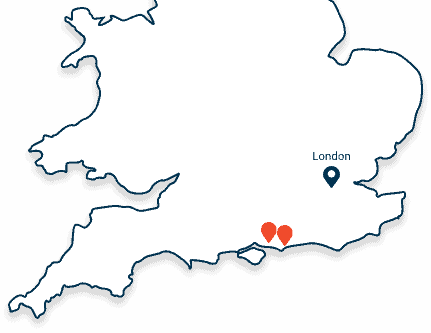Police officer turned academic to research domestic abuse risk assessment tools to improve outcomes

Amber Leeson is a former police officer and a PhD student in psychology at University of Chichester. As part of her policing role, she was involved in risk assessments of domestic abuse using the DASH/DARA risk assessment but found the tools lacking.
She is now researching the use of this tool by police and non-police staff as part of her research, and the survey can be found here.
We spoke to Amber about what inspired her to carry out the research and the change she hopes it will make for survivors of domestic abuse.
Can you tell us about your experience of policing particularly in relation to domestic abuse?
When I first joined the police in 2023, I believed that domestic abuse (DA) was uncommon. Throughout training, they drilled into us that DA was extremely common and that we should prepare for this.
My Sergeant told me that domestics will become my ‘bread and butter’, so I needed to be well versed in policy and legislation. I remember my first ever Grade 1 emergency call was a domestic… a male had assaulted his wife in their home address and split her lip open. From this day until the day I left the police, I would go on to attend domestics every single shift. It was relentless, it was heart-breaking, and it changed me as a person.
I saw everything from non-crime domestics (an argument) to being the first on scene to a domestic homicide. I learned a very hard lesson that domestic abuse is everywhere, regardless of gender, class, income or age. It happens behind closed doors and in public. The prevalence of domestic abuse must not be underestimated.
Why did you decide to make the transition from policing into academic research?
After two years in the police, I knew that I had grown up a lot and had changed as a person. I was wiser, more aware of what really happened on people’s doorsteps, but I also had ideas for future research spinning in my head. Whenever I witnessed something that I thought could be improved, such as safeguarding procedures, I would research it and find out what academics were doing to correct these pitfalls.
I felt the place where I would thrive the most and make the biggest change would be at University. The academic part of me never left and was urging me it was time to pursue this dream.
What drives you and motivates you?
I have witnessed first-hand hundreds of domestic abuse incidents. I have made arrests, spoken to witnesses and tried to safeguard victims during a crisis. I have wiped away blood and put children back to bed after a horrific incident has occurred in their home. The police are overworked and understaffed, and safeguarding is not always, in my opinion, good enough. I want to improve policy and procedures used to safeguard victims of domestic abuse because of the fragile situation they find themselves in. Leaving an abuser is not a single event, but a process, that needs to be supported by all agencies.
There are people living in fear in a place that is meant to be their safe haven, their home. I wholeheartedly believe that more must be done to help break this cycle and allow victims to have their freedom back.
Based on your experience, what are the crucial aspects that the current risk assessment tools miss, and how do you think this can be resolved?
Firstly, the risk assessment tool used in the majority of police forces in the UK is called DASH (Domestic Abuse Stalking and Harassment). There is also DARA (Domestic Abuse Risk Assessment). These tools are designed to score the risk to the victim as standard, medium or high, which will then dictate what happens next to safeguard this victim.
Picture this – you have just been assaulted by someone who should love you. A stranger in a black uniform, with a taser, baton, cuffs and pepper spray approaches you, gets out a mobile phone and logs into it. They then sit down with you and ask “So… has the current incident resulted in injury?” Or “How often does (…) make threats to harm you or things you care about, such as people pets or property?” Just let that sink in… No rapport established at all, but the police go straight in with these questions and expect a victim to be able to answer. It is overwhelming and harsh. I think this could be massively improved with prompts at the top of the form to allow the officer to build rapport, and regular training for officers around domestic abuse.
Also, domestic abuse crimes such as coercive control are often missed when completing these forms – coercive control by its definition, is more subtle than a physical assault. It includes gaslighting a victim and instilling fear of consequences. Questions are asked in both forms such as “Does (…) ever try to control you…” but if a victim answers “No” this may be taken as the truth when it is not. Again, regular police training around coercive control is vital in allowing officers to spot this and ask questions if they suspect a person is a victim of coercive control.
Finally, the form does not ask about victim’s mental health or neurodiversity. The DASH and DARA both ask questions relating to suicidal thoughts and depression, but nothing else. This is very limited. If a victim has autism, this will affect their engagement, thought processes, understanding of their situation and next steps. But this is not considered when assessing risk to a victim and how it may impact their ability to leave their abuser and support a police prosecution. Both are long and difficult processes.
What will be your next steps when the research is complete, and how are you hoping to influence and inspire change?
I’ll continue to research and push for change for domestic abuse victims. No one should have to live with relentless fear, control or distress.
Educating professionals is vital for improving risk assessment tools and how they are completed with victims. I would love to design and implement new questions to the current DASH/DARA forms and study if they improved the responses from victims and effectiveness of safeguarding from the police.
You can complete the survey Risk Assessment in Domestic Abuse here.





